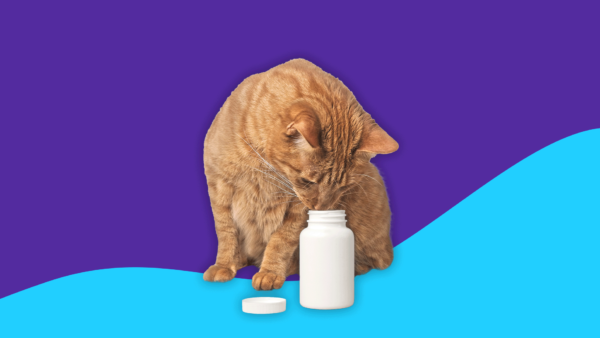When you notice your otherwise healthy dog throwing up white foam for no apparent reason, it’s normal that you will be concerned. This white foam may look like foamy saliva or vomit, similar to soap lather.
Throwing up white foam can occur in dogs regardless of age or breed. Vomiting white foam could just be due to an upset stomach, or it could be a sign of something more serious. “Dogs sometimes vomit white foam if they’ve eaten something that doesn’t agree with them or if they’ve eaten grass. It could also be a sign that their stomach is empty,” says Sara Ochoa, DVM, a veterinarian with The Animal Hospital of West Monroe and co-founder of howto-pets.com. Or, it could be more serious, signaling underlying health conditions like gastritis, pancreatitis, kennel cough, bloat, and bilious vomiting syndrome.
In this article, we explain the most common reasons for white foam vomit (both medical and nonmedical reasons) and the available treatment options.
Dog throwing up white foam: Medical and nonmedical reasons
There are various reasons why your dog may start throwing up white foam. Some are due to an underlying condition, while others are nonmedical.
1. Gastritis
Gastritis is when the lining of the stomach is inflamed. It can be either acute (lasting less than 24 hours) or chronic (developing gradually and lasting for a long period). The causes of gastritis in dogs are most likely multifactorial, involving ingestion of garbage (such as molds, fungi, spoiled or raw food, leftovers, or cat litter), stress, food-allergy reactions, bacteria infection, and overuse of drugs such as nonsteroidal anti-inflammatory drugs (NSAIDs), corticosteroids, antibiotics, and chemotherapeutics. Apart from throwing up white foam, other clinical signs of gastritis in dogs include loss of appetite, lethargy, depression, excessive thirst, blood in the vomit or feces, and abdominal pain.
Acute gastritis associated with minor conditions can often be resolved quickly with simple treatments. Your veterinarian may advise you to wait up to 24 hours before feeding your dog or feeding small portions of low-fat, low-fiber food over the next two to three days. If the remedies fail, or if it is a chronic gastritis case, treatment will depend on the underlying causes.
2. Pancreatitis
If your dog keeps throwing up white foam, it may suggest pancreatitis. “The inflammation of the pancreas can lead to vomiting white foam, abdominal pain, and a hunched back. This condition can range from mild to severe and may require immediate veterinary attention,” Dr. Ochoa says.
In dogs, dietary indiscretion and a high-fat diet are common causes of pancreatitis. Dogs of certain breeds, such as miniature schnauzers and some smaller toy and terrier breeds, are at a higher risk for pancreatitis. Pancreatitis may also be caused by certain medications and toxins, trauma, and diabetes mellitus.
Pancreatitis is life-threatening. Symptoms include vomiting excessively, abdominal pain, diarrhea, dehydration, decreased appetite, lethargy, and fever. If your dog is throwing up white foam and has any of these additional symptoms, it’s important to seek immediate medical attention. Treatment may include intravenous fluids, antiemetic drugs to stop the vomiting, and dietary changes.
3. Bloat
Also called gastric dilatation-volvulus (GDV), bloat is a medical emergency that can become fatal if untreated. It occurs when a dog’s stomach twists and flips on itself, trapping fluid and gas within the stomach. Bloat is a medical emergency because the distended stomach cuts off blood flow to important organs.
GDV affects all breeds, but large-breed dogs with deep chests are at a higher risk. As a dog owner, you should know how to recognize the symptoms in your pet. Other than white foamy vomit, symptoms of GDV include restlessness, pacing, a swollen or distended abdomen, distress, retching without vomiting, excessive drooling, panting, and inability to stand. Surgery can correct the stomach rotation, and early detection is very important for a good outcome. Take your dog to the vet immediately if you notice these early symptoms.
4. Kennel cough
Kennel cough is a respiratory disease that may be caused by a bacteria or virus. Symptoms include a forceful hacking cough (almost as if they have something stuck up their throat) that may be followed by the dog throwing up white foamy liquid. Kennel cough is highly contagious and may spread amongst dogs if they come in contact with infected objects like toys, food bowls, or other shared objects. “If your dog has been socializing with other dogs, keep an eye out for this possibility,” Dr. Ochoa says.
Usually, kennel cough is not serious and may heal on its own within a few weeks. However, in puppies, elderly dogs, and immunocompromised dogs, kennel cough may be severe and can lead to pneumonia if left untreated. During recovery, keep your home well-ventilated and avoid using collars and a leash, as they can irritate the windpipe and worsen the condition. Your veterinarian may also prescribe antibiotics, cough suppressants, and anti-inflammatories to treat kennel cough. Vaccination against Bordetella bronchiseptica may also help prevent kennel cough.
5. Bilious vomiting syndrome
“If your pup throws up white foam mostly in the mornings or after a long period without eating, it could be bilious vomiting syndrome. This happens when bile irritates the stomach lining and leads to vomiting,” Dr. Ochoa says. If your dog has bilious vomiting syndrome, they’ll likely throw up in the early mornings or late at night when on an empty stomach. Bilious vomiting syndrome may occur in dogs infected with giardia or those with food allergies or inflammatory bowel disease. Treatment includes intravenous fluid, H2 blockers such as Tagamet or Pepcid, small frequent meals, or antiparasitic medication such as fenbendazole or metronidazole if a parasite like giardia is the culprit.
6. Acid reflux
Acid reflux or gastroesophageal reflux disease (GERD) affects dogs of all ages. Acid reflux happens when stomach acids flow back into the esophagus, irritating the esophageal lining. Causes of acid reflux in dogs include a weak lower esophageal sphincter that struggles to prevent food from moving back to the esophagus, high-fat foods, and underlying medical conditions like gastritis, pancreatitis, and inflammatory bowel disease. Other than throwing up white foam, common signs and symptoms include regurgitation, excess salivation, gagging or persistent swallowing, cough, bad breath, and anxiety. Some dogs may not show signs of acid reflux. Treatment options vary depending on the causes.
7. Parvovirus
Parvovirus is a viral disease that causes bloody diarrhea, frequent vomiting, lack of appetite, and severe dehydration in dogs. Dogs who have been vaccinated are commonly protected from this disease, but puppies or immunocompromised dogs can become very sick if exposed to the virus. Parvovirus is contagious and spreads through contact with infected dogs or sniffing contaminated feces and vomit. Since young puppies are especially prone to dehydration from vomiting, any dog under a year of age who is not eating or is repeatedly vomiting should be seen by a veterinarian right away. Parvovirus infection is quickly diagnosed through a test performed at most vet clinics. Treatment includes fluid therapy, antibiotics to treat secondary bacterial infections, and antiemetics to stop vomiting. It’s best to vaccinate your dog against parvovirus, as there’s no drug to kill it. Your vet can only treat the symptoms while hoping the immune system fights the disease.
8. Dietary indiscretion
“Just like humans, dogs can get an upset stomach from eating too fast, changing diets suddenly, or ingesting something that doesn’t agree with them. This can lead to irritation of the stomach lining and the production of white, frothy vomit,” Dr. Ochoa says.
If the dietary indiscretion leads to intestinal obstruction, you’ll need to get your dog immediate medical attention. Intestinal obstruction can occur when your dog eats something they shouldn’t, and it blocks their intestinal tract. Symptoms of an obstruction include repeated vomiting, decreased appetite, lethargy, and abdominal pain. If your dog is repeatedly vomiting or you suspect they ingested something that could cause an obstruction, take your dog to the vet’s office immediately.
What should I do if my dog is throwing up white foam?
If it’s only a single incident of throwing up white foam, follow the wait-and-see approach. The dog may get better without treatment. You can also withhold food for about 12–24 hours or feed them smaller quantities while watching for improvement. But, if their condition gets worse or they’re in distress, it’s best to take your pet to the vet for proper evaluation and appropriate treatment.
Dr. Ochoa has the following suggestions on what to do about your pup throwing up white foam:
- Keep calm. Throwing up white foam can be a sign of many things, from benign to more serious issues.
- Check for other symptoms. Is your dog acting normally otherwise, or are they lethargic, refusing food, or having diarrhea? Additional symptoms can point toward the severity of the situation.
- Recall your dog’s recent activity. Did they get into the garbage, eat something unusual, or gulp down their food too fast? Sometimes, white foam is simply a sign of an upset stomach.
- Ensure they have access to water. Vomiting can lead to dehydration, so make sure your dog has plenty of fresh water available.
- Rest their stomach. Avoid feeding for a few hours to let their stomach settle. When you reintroduce food, go for something bland like boiled chicken and rice.
If the vomiting continues, or if other concerning symptoms accompany it, it’s important to contact your veterinarian.
Bottom line
Vomiting white foam is not always a call for concern, especially when it’s just one episode. Dog owners know that it’s normal for dogs to get sick, vomit, and possibly go on with their day without having problems. However, if, in addition to throwing up white foam, they show other signs of illness, take your dog to the vet’s office to find out the underlying cause of your dog throwing up white foam. The dog will undergo some diagnostic tests like blood work. The good news is that most possible causes are treatable.
Sources
- Canine gastritis, Veterinary Clinics of North America: Small Animal Practice (2003)
- Gastritis in dogs, VCA Animal Hospitals
- Pancreatitis in dogs – symptoms, causes & treatment, American Kennel Club (2021)
- Gastric dilatation-volvulus, American Colege of Veterinary Surgeons
- Canine infectious respiratory disease complex (kennel cough), American Veterinary Medical Association
- Stomaching the problem: Could your pet have bilious vomiting syndrome?, Tufts University (2021)
- Esophagitis in dogs, West Suburban Humane Society











